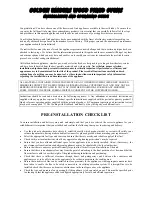
GB
14
Lighting Instructions
Lighting in the right
way
It is important that the correct amount of wood is used, especially
when lighting. If you are lighting the fire for the first time you
should use a set of scales to see how much 3 kg kindling is.
Also check what the normal and maximum weights look like.
Always open the hatch carefully and slowly to prevent blow back
because of the changing pressure in the stove.
The function of the insert differs depending on the draft conditions
in the chimney. Achieving the correct setting for the combustion air
damper usually takes a few attempts.
In order to obtain a good bed of embers, there should always be a
thin layer of ash and charred pieces in the fire box.
Lighting
If the house has mechanical ventilation, open a window near to the
fireplace prior to lighting. Leave the window
open for a few minutes until the fire has caught properly.
1. Open the control for the combustion air fully.
2. Insert paper or firelighters, and about 3 kg of thinly chopped
wood into the centre of the firebox. Stack the wood crosswise.
3. Light the fire.
4. Close the door, but leave it open 4-5 cm (lighting position)
5. When the fire has caught fully after approx 5-10 minutes, close
the hatch completely.
6. The first load of logs should not be put on until the start up fire
has become a glowing bed of embers.
Adding wood
1. Open the hatch a few centimetres and allow the vacuum in the
firebox to equalise for a few seconds before opening the hatch
fully.
2. Add 2-3 logs of a combined weight of approx 2-3 kg. Place one log
diagonally and one or two logs on top. Then close the door.
3. The combustion damper must be completely open for 3-5
minutes until the logs turn black and catch fire.
If slower combustion is then required, the supply of combustion
air can be reduced. The conditions for controlling combustion
vary depending on the temperature in the stove and the draft in
the chimney.
4. A nominal energy output of 9 kW is achieved when the
combustion air damper is 40% open and 3 logs weighing about
2.5 kg are added once per hour.
5. The lowest output of 6 kW is obtained when the combustion
air damper is 20% open and two logs are lit. In this operating
position it is important that the combustion air damper is fully
open for the first 3-5 minutes so that the wood has time to
burn properly before the supply of combustion air is reduced. A
condition for regulating the output is a thick bed of embers and
high temperature in the firebox. When the fire has died down to
embers more wood should be added.
LIGHTING FOR THE FIRST TIME
The hearth insulation in your new insert consists of
Thermotte®, a stone material with excellent insulating
properties. It contains a certain amount of water that
evaporates during the first lighting. Whilst this happens,
combustion may seem to be slow, and soot may build up
on the insulation panels. Do not compensate for the slow
combustion by adding to the fire as this risks cracking the
panels if they are put under ”stress” before they have cured.
When the panels regain their white colour they can be
considered to have cured. The insert will emit an odour of
excess paint and oil coating that may remain on the panels.
The odour will disappear completely after several fires.
Feeding Wood:
Chopped wood
Length: 25-50 cm
Diameter: 7-10 cm
Normal weight: 2.5 kg/hour
Max amount: 4 kg/hour
(max 3 pieces per insertion. Max 4 kg per insertion)
QUICK LIGHTING
It is important that the wood catches fire
quickly. Quick lighting is achieved by opening
the combustion air damper fully or by leaving
the door ajar for a moment. Pyre lighting
produces a lot of smoke and can cause quick
gas ignition in the worst instance resulting
in hearth damage.
Correctly sized wood
Note that if too little kindling is used when lighting, or if the wood
is too thickly cut, the fire box will not reach the correct operating
temperature. Incorrect lighting can lead to poor combustion with
heavy sooting and may result in the fire going out when the door is
shut.
Kindling:
Finely chopped wood
Length: 25-35 cm
Diameter: 3–5 cm
Weight per lighting: 3.0 kg
(approx. 10-12 finely chopped
pieces)






















